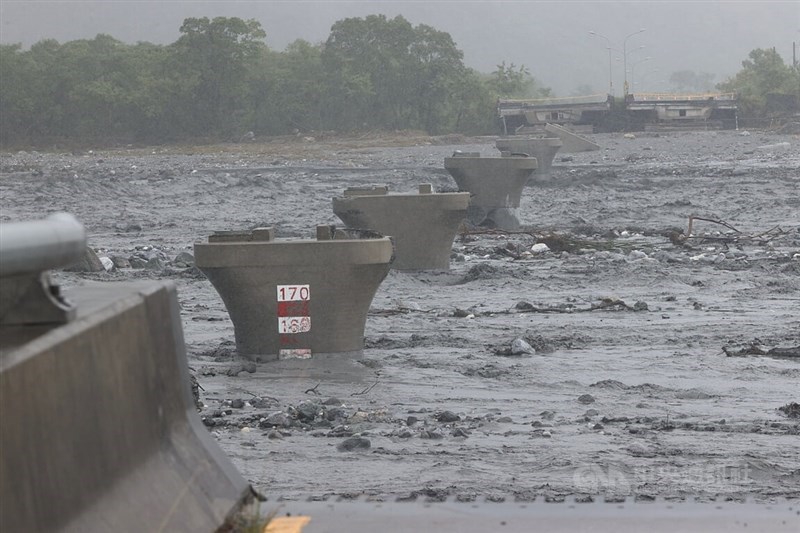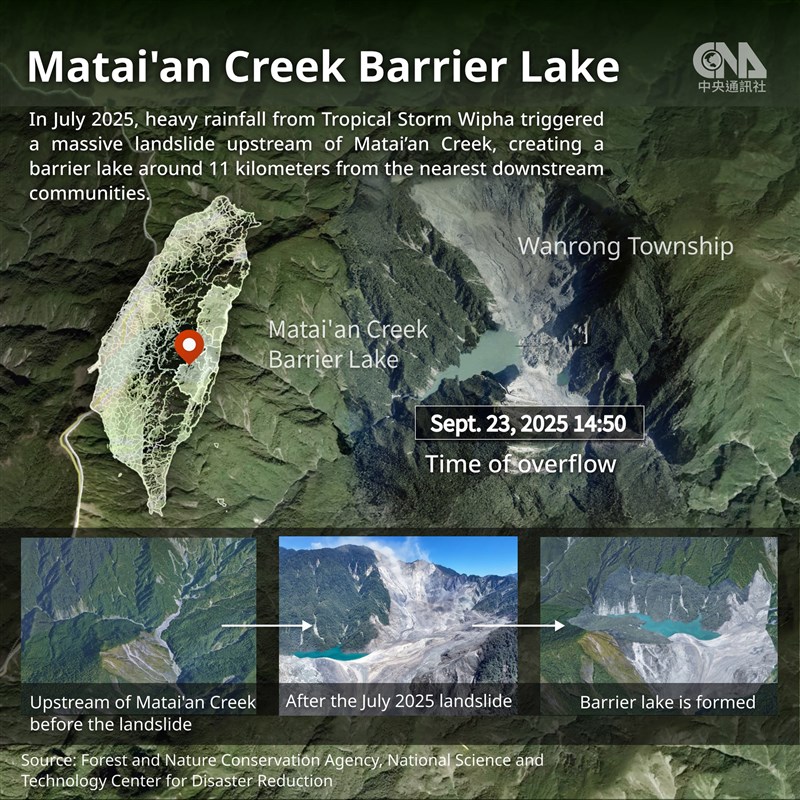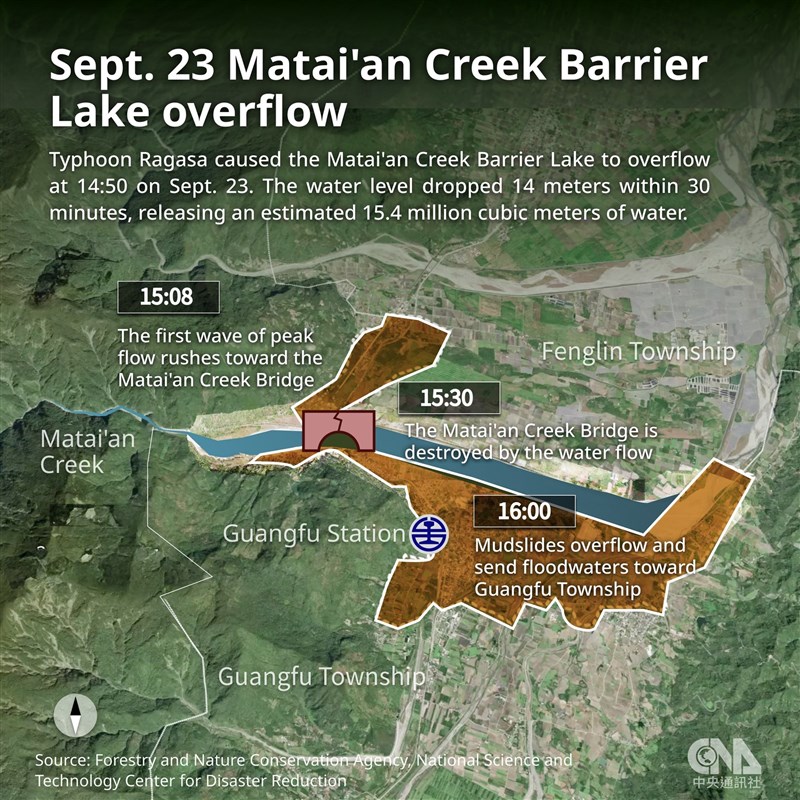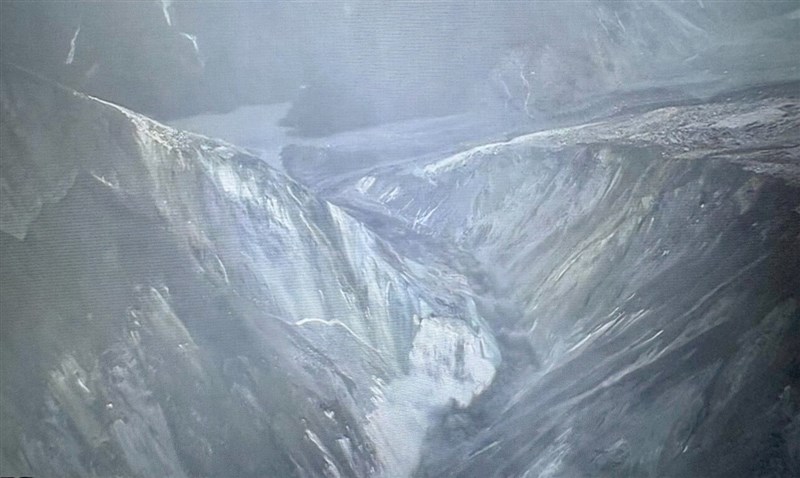
Taipei, Sept. 24 (CNA) A barrier lake on the Matai'an Creek in Hualien County overflowed on Tuesday, causing severe flooding in the eastern Taiwan county's Guangfu, Wanrong and Fenglin townships.
● Hualien barrier lake water levels drop, but evacuations continue: CEOC
● Evacuations urged in Hualien as barrier lake risks renewed overflow
What is a barrier lake?
A barrier lake forms when debris from an earthquake, heavy rainfall, or a landslide blocks a river and creates a natural dam.
Why are barrier lakes dangerous?
Such natural dams are often loosely structured, making them prone to erosion and collapse, especially as water accumulates, potentially causing catastrophic damage downstream.
How was the Matai'an Creek Barrier Lake formed?
In July, severe rain brought by Tropical Storm Wipha caused a massive landslide in the upstream forest land along Matai'an Creek, creating the lake.
The Forestry and Nature Conservation Agency initially assessed the dam as stable, launched simulations and risk evaluations and began real-time monitoring.

Impact and casualties from the overflow
On Tuesday, as Typhoon Ragasa brought torrential rain, the lake began overflowing at 2:50 p.m.
Approximately 15.4 million cubic meters of water -- roughly the volume of 6,000 Olympic-size swimming pools -- spilled out from the lake in just 30 minutes.
The water flooded downstream into Guangfu, Fenglin and Wanrong townships, causing 17 deaths, 17 missing and 32 injured, as of 5 p.m. Wednesday, according to authorities.
The highest number of fatalities was found on Dunhou Road and Fozu Street in Guangfu, mostly among elderly people on the ground floor who were unable to evacuate in time.

Government response to the lake
The lake was formed on July 21, and the central government had established an emergency response team by late July to conduct aerial surveys, modeling and risk assessment.
Early August saw joint meetings with local officials and the implementation of preventive measures.
On Aug. 12, Typhoon Podul prompted the evacuation of 697 people from 259 households, and inspections after the storm found the barrier lake's dam to be stable, but monitoring continued.
At the end of August, the Ministry of Agriculture (MOA) established a special task force, which was instructed to clear debris, reinforce bridges and enhance monitoring ahead of potential overflows in early October.

In September, a team from National Dong Hwa University produced updated evacuation maps, while targeted emergency alerts and evacuation drills were conducted in Guangfu, Wanrong and Fenglin.
Teams from National Yang Ming Chiao Tung University and National Taiwan University were also commissioned by the MOA and the Ministry of the Interior to map areas that may be affected by overflows.
The Central Emergency Operations Center held a meeting on Sunday, evaluating that about 1,800 households in Hualien County needed to be evacuated, and relevant mapping data was supplied to local authorities.
Preventive measures were activated on Tuesday in response to heavy rainfall from Typhoon Ragasa.
Why was the lake not drained in advance?

After the lake's formation, the MOA held meetings attended by multiple government bodies to discuss options, such as excavating the dam wall, controlled blasting and siphon pumping.
However, according to the MOA, the remote mountain location and a lack of road access meant heavy equipment and siphon pipes could not be implemented quickly enough.
Blasting was ruled out, as the dam wall -- measuring around 200 million cubic meters in volume and 2.3 kilometers in length -- posed a risk of catastrophic collapse if the surrounding ground were destabilized.
Authorities said that they therefore focused on enhanced monitoring and downstream disaster mitigation.
How were barrier lakes in Taiwan managed in the past?
Between 1979 and 2025, 88 barrier lakes were recorded in Taiwan, most notably after the 921 Earthquake in 1999 and during Typhoon Morakot in 2009, when a flood caused by a barrier lake collapse destroyed Siaolin Village, part of what was then Kaohsiung County. A total of 462 village residents were buried alive by a massive landslide.
The 921 Earthquake triggered barrier lakes at Caoling in Yunlin County and Jiufenershan in Nantou County, where emergency overflow channels and dam stabilization works were carried out.
Jiufenershan's dam was also reinforced using shipping containers filled with gravel to stabilize slopes and prevent surface water seepage.
After Typhoon Morakot, several barrier lakes formed in Pingtung, Taitung and Kaohsiung, and they were managed primarily through overflow channels, drainage pipes and close monitoring.
As of Wednesday, automated monitoring of barrier lakes remains in place for Matai'an Creek in Hualien and Taigang Creek in Hsinchu County.
![The Cabinet's refusal to sign revised revenue-sharing law]() The Cabinet's refusal to sign revised revenue-sharing lawPremier Cho Jung-tai (卓榮泰) on Monday said that he will refuse to countersign amendments to a revenue-sharing law passed by the opposition-controlled Legislature -- an unprecedented action no Republic of China (Taiwan) government has previously taken.12/16/2025 08:57 AM
The Cabinet's refusal to sign revised revenue-sharing lawPremier Cho Jung-tai (卓榮泰) on Monday said that he will refuse to countersign amendments to a revenue-sharing law passed by the opposition-controlled Legislature -- an unprecedented action no Republic of China (Taiwan) government has previously taken.12/16/2025 08:57 AM![Everything you need to know about how to get NT$10,000 cash handout]() Everything you need to know about how to get NT$10,000 cash handoutThe Executive Yuan announced Thursday that registration for a one-time universal NT$10,000 (US$321) cash handout to help people in Taiwan survive Trump-era tariffs and inflation will start on Nov. 5, with payouts available as early as Nov. 12.10/24/2025 02:27 PM
Everything you need to know about how to get NT$10,000 cash handoutThe Executive Yuan announced Thursday that registration for a one-time universal NT$10,000 (US$321) cash handout to help people in Taiwan survive Trump-era tariffs and inflation will start on Nov. 5, with payouts available as early as Nov. 12.10/24/2025 02:27 PM![High-speed rail's latest 'Quiet Space' rules]() High-speed rail's latest 'Quiet Space' rulesTaiwan High Speed Rail (THSR) has implemented new "Quiet Space" rules requiring passengers to use earphones and make phone calls in the gangways, effective Sept. 22.10/14/2025 09:13 PM
High-speed rail's latest 'Quiet Space' rulesTaiwan High Speed Rail (THSR) has implemented new "Quiet Space" rules requiring passengers to use earphones and make phone calls in the gangways, effective Sept. 22.10/14/2025 09:13 PM
- Society
Mercury set to drop as low as 10°C in 17 counties, cities Thursday
01/07/2026 09:33 PM - Business
Taiwan's inflation below 2% alert in 2025, lowest in 5 years
01/07/2026 08:47 PM - Culture
Taipei Int'l Book Exhibition to feature at least 18 Thai authors
01/07/2026 08:47 PM - Business
Fair Trade Commission approves Uber's acquisition of Crown Taxi
01/07/2026 08:12 PM - Culture
NCKU tops Taiwan's 2026 University Brand Power survey
01/07/2026 06:53 PM


